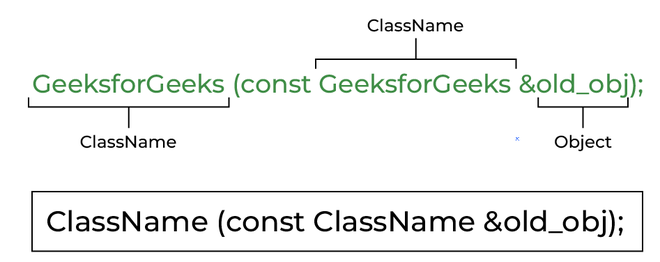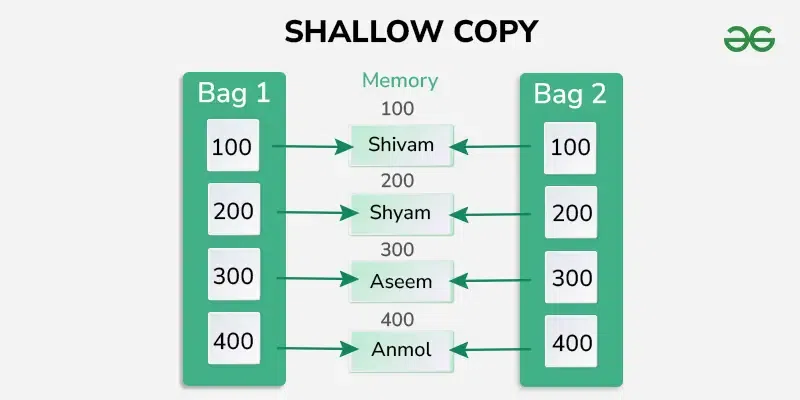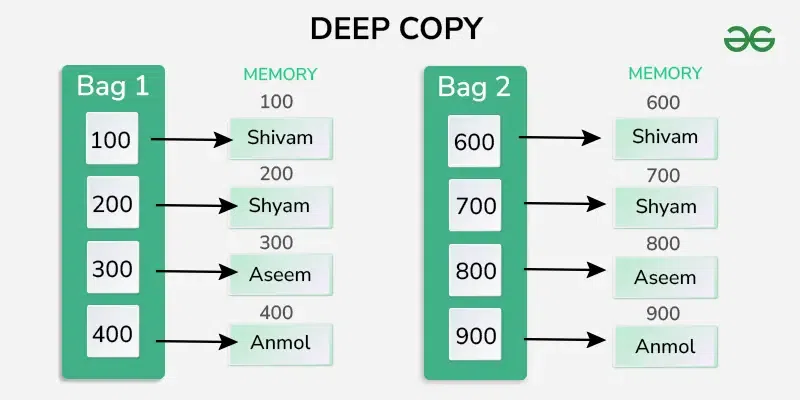A copy constructor is a special type of constructor used to create a new object using an existing object of the same class.
- Compiler creates a default copy constructor if there is no user defined constructor. This compiler created constructor does a shallow copy and works well for basic types, but does not work for dynamic allocated memory.
- If a class has pointers or runtime resources (like dynamic memory, file handles, network connections), a custom copy constructor is needed. Otherwise, deletion of one object might cause deletion of an unrelated object members.
Default Copy Constructor
In this example, a1 is created and its member x is set to 10. Then a2 is created using the copy constructor, so it becomes a copy of a1 with the same value of x.
C++ #include <iostream> using namespace std; // Create a demo class class A { public: int x; }; int main() { // Creating an a1 object A a1; a1.x = 10; cout << "a1's x = " << a1.x << endl; // Creating another object using a1 A a2(a1); cout << "a2's x = " << a2.x; return 0; } Outputa1's x = 10 a2's x = 10
User Defined Copy Constructor
C++ also allows programmers to create their own version of copy constructor known as user defined or explicit copy constructor.
C++ className (const ClassName &obj) { // Body of copy constructor } Here, the const is optional but is added so that we do not modify the obj by mistake. Copy constructor takes a reference to an object of the same class as an argument.
 Syntax of Copy Constructor CPP
Syntax of Copy Constructor CPP #include <iostream> using namespace std; class A { public: int x; A(){}; // Copy Constructor definition A(A &obj) { x = obj.x; cout << "Copy constructor " "called" << endl; } }; int main() { // Creating an object of class A A obj1; obj1.x = 10; cout << "obj1's x = " << obj1.x << endl; // Creating another object by copying already created object A obj2(obj1); cout << "obj2's x = " << obj2.x; return 0; } Outputobj1's x = 10 Copy constructor called obj2's x = 10
Note: If we define a copy constructor, then implicit definition of the default constructor will not be provided by the compiler. So, we would have to manually define it too.
Need of User Defined Copy Constructor
- If no copy constructor is defined, C++ provides a default copy constructor.
- The default copy constructor performs a shallow copy, shallow copy copies pointer values, not the actual resources they point to.
- If a class has pointers or runtime resources (like dynamic memory, file handles, network connections), a custom copy constructor is needed.
- Without a custom copy constructor, shallow copy can lead to dangling pointers or resource conflicts.
 Shallow Copy
Shallow Copy- Deep copy is possible only with a user-defined copy constructor.
- In a user-defined copy constructor, we make sure that pointers (or references) of copied objects point to new copy of the dynamic resource allocated manually in the copy constructor using new operators.
 Deep Copy
Deep CopyFollowing is a complete C++ program to demonstrate the use of the Copy constructor. In the following String class, we must write a copy constructor.
C++ #include <bits/stdc++.h> using namespace std; class String { private: char *s; int size; public: String(const char *str) { size = strlen(str); s = new char[size + 1]; strcpy(s, str); } ~String() { delete[] s; } String(const String &old_str) { size = old_str.size; s = new char[size + 1]; strcpy(s, old_str.s); } void print() { cout << s << endl; } void change(const char *str) { delete[] s; size = strlen(str); s = new char[size + 1]; strcpy(s, str); } }; int main() { String str1("GeeksQuiz"); // Create str2 from str1 String str2 = str1; str1.print(); str2.print(); // Update the str2 object str2.change("GeeksforGeeks"); str1.print(); str2.print(); return 0; } OutputGeeksQuiz GeeksQuiz GeeksQuiz GeeksforGeeks
Note: Such classes also need the overloaded assignment operator. See this article for more info - C++ Assignment Operator Overloading
What would be the problem if we remove the copy constructor from the above code?
If we remove the copy constructor from the above program, we don't get the expected output. The changes made to str2 reflect in str1 as well which is never expected. Also, if the str1 is destroyed, the str2's data members will be pointing to the deallocated memory.
When is the Copy Constructor Called?
In C++, a copy constructor may be called in the following cases:
- When an object of the class is returned by value.
- When an object of the class is passed (to a function) by value as an argument.
- When an object is constructed based on another object of the same class.
- When the compiler generates a temporary object.
It is, however, not guaranteed that a copy constructor will be called in all these cases, because the C++ Standard allows the compiler to optimize the copy away in certain cases, one example is the return value optimization (sometimes referred to as RVO).
Copy Elision
In copy elision, the compiler prevents the making of extra copies by making the use to techniques such as NRVO and RVO which results in saving space and better the program complexity (both time and space); Hence making the code more optimized.
Copy Constructor vs Assignment Operator
The main difference between Copy Constructor and Assignment Operator is that the Copy constructor makes a new memory storage every time it is called while the assignment operator does not make new memory storage.
Which of the following two statements calls the copy constructor and which one calls the assignment operator?
C++ MyClass t1, t2; MyClass t3 = t1; // ----> (1) t2 = t1; // -----> (2)
A copy constructor is called when a new object is created from an existing object, as a copy of the existing object. The assignment operator is called when an already initialized object is assigned a new value from another existing object. In the above example (1) calls the copy constructor and (2) calls the assignment operator.
Explore
C++ Basics
Core Concepts
OOP in C++
Standard Template Library(STL)
Practice & Problems
My Profile